Editing models inside my engine has been something I wanted to support for a long time now. Especially when you're not the one creating the assets, but do have to work with them inside the editor it can be time consuming to send back a model with incorrect material names or a mesh that should be split to optimize rendering, or vice versa. With this tool I will eliminate the need to have artists re-export their models because of tiny mistakes/changes and should provide a much cleaner pipeline in general.

Currently only the very core of this feature has been implemented (as seen in the video) and a lot of other stuff is still to follow, I will give a brief overview of how the fully functional tool should work once its complete. When any new model (.fbx or .x) is imported, it's processed by the content pipeline and turned into an .xnb file, an .xml file will be attached to the source (model) file that contains all changes to the model and will be processed during build-time. By default this .xml file is empty and nothing altered, during run-time a mesh can be converted to Editable Mesh (trying to keep this similar to 3D Studio Max's naming conventions) which allows vertex and triangle selection with support for any type of transformation that is supported by the gizmo component (translate, rotate, scale in local- and world-space) these transformations are stored inside Actions (I will talk about Actions a lot more at a later time, but it's basically what you use to support undo/redo in any kind of editing software) and written to the model Xml. The model is then re-build the next time the project is build and the actions are applied, this can hold any type of alteration including material renaming, splitting meshes and deleting / adding new vertices alongside vertex transformations.
Because the source model remains untouched, whenever the model is re-exported from any DCC-tool like 3D Studio Max or Maya the model will still build with all transformations and alterations applied. An example: A material named '
#46 Material' is renamed at run-time to '
corridor_floor', if the artist then changes the name of '
#46 Material' to '
corridor_floor' or something else in the source model, the run-time change is ignored because the original material name (
#46 Material) can no longer be found... in a worst-case scenario this ignores the material properties you stored for the original name (material properties are stored elsewhere, so no data is actually lost) so even in the worst case, you are only a small step away from re-applying your previous changes (A warning dialog with failed conversions should help with this, making it potentially very quick and painless to manually re-assign the changes that are never lost, just ignored till resolved) The same applies to vertex transformations, but these can be a bit more difficult to keep track of once the indices of a certain mesh change inside the .fbx source file.
There is still a significant amount of work that has to be completed before this feature takes it full shape, with this first proof of concept up and running I believe it will be a very valuable tool to have available, and a lot of fun to create :)
It proved to be quite easy to convert the gizmo to support vertex manipulation (and selection) I will add these changes to the codeplex project at some point in the future...









































